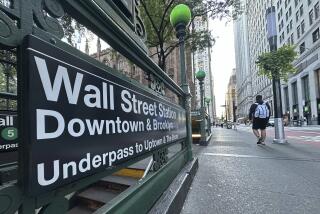Stocks open modestly lower after prior day’s gains
- Share via
NEW YORK — After two powerful sell-offs in three days caused by growing concerns about the economic recovery’s staying power, the stock market may be facing its biggest test since launching into a blazing rally almost eight months ago.
Stocks have weakened significantly in the last two weeks despite a string of generally impressive corporate earnings reports. After falling almost 250 points Friday, the most in three months, the Dow Jones industrial average is down 3.8% from its 2009 peak reached Oct. 19.
The broader Standard & Poor’s 500 index is down 5.6% during the same stretch. Measures of small stocks and foreign shares have posted even sharper declines.
After celebrating the rebounding economy Thursday, when the Dow surged almost 200 points after the government reported that the U.S. economy expanded at a solid 3.5% annual rate in the third quarter, investors worried Friday that such growth won’t be sustainable.
The focus of investors worries: potentially anemic consumer spending as the government’s economic stimulus efforts wind down.
The bottom line, some analysts say, is that the torrid rally that carried the Dow up 54% and the S&P; up 62% from March to early this month overshot the actual condition of the economy.
“The odds are good that we have hit the highs for the year,” said David Dietze, strategist at Point View Financial Services in Summit, N.J. “We’ve come too far too fast. We need a little bit more progress on the fundamentals of the economy before we can move higher.”
Separate measures Friday spotlighted the tentative mood of Americans. The government reported that although personal income was flat in September, Americans reduced their spending by 0.5% from August, when spending jumped 1.3%, fueled by the popular “cash-for-clunkers” car rebate program.
And consumer sentiment fell in October from September, according to a Reuters/University of Michigan index, though the decline was somewhat smaller than previously estimated.
But neither of the reports was worse than expected. And more bullish analysts say the selling Friday and earlier in the week was driven partly by year-end tax considerations of mutual funds whose fiscal year ends today. Under that theory, some fund managers were selling to lock in tax losses.
As the tax-related selling subsides, these analysts say, buyers will reemerge just as they have each time stocks have dropped since March.
“Right now we’re in that zone where any little pullback is going to spook people into thinking it’s the beginning of the end,” said Patrick J. O’Hare, chief market analyst at Briefing.com. “You’re going to continue to see these pullbacks as buying opportunities for those people who essentially missed out on a good part of this rally and want to get in.”
The Dow fell 249.85 points, or 2.5%, on Friday to 9,712.73. The S&P; 500 tumbled 29.92 points, or 2.8%, to 1,036.19. For both indexes the day marked their biggest one-day percentage drops since July 2. The Nasdaq composite index sank 52.44 points, or 2.5%, to 2,045.11.
Six stocks fell for every one that rose on the New York Stock Exchange.
For the week, the Dow lost 2.6%, the S&P; tumbled 4% and the Nasdaq gave up 5.1%.
For the month of October, the Dow was essentially flat (it gained less than half a point), while the S&P; lost 2% and the Nasdaq fell 3.6% -- their first monthly slides since February.
Volume was weak during much of the rally that began in the spring but has recently increased on down days, a sign that investors are anxious to unload shares.
Other financial markets Friday also pointed to concerns about the economy. Commodity prices fell broadly, led by a 3.5% slide in oil. The dollar, a refuge in turbulent markets, rose for the fifth time in six days. And yields on Treasury securities fell as investors sought safe harbor. The 10-year note sank to 3.39% from 3.50%.
As the Dow’s 200-point gain Thursday was erased and then some Friday, many investors were reminded of the dramatic moves -- mostly down but sometimes up -- that were a hallmark of the bear market in 2008 and early this year.
A measure of expected stock-price volatility shot up 24%Friday, its biggest one-day rise this year, suggesting that a recent period of sustained calm may be giving way to another bout of unsettling volatility.
“These moves,” warned Joe Cusick, senior market analyst at brokerage OptionsXpress, “could get much larger and potentially violent, both to the upside and the downside.”
--
More to Read
Inside the business of entertainment
The Wide Shot brings you news, analysis and insights on everything from streaming wars to production — and what it all means for the future.
You may occasionally receive promotional content from the Los Angeles Times.










